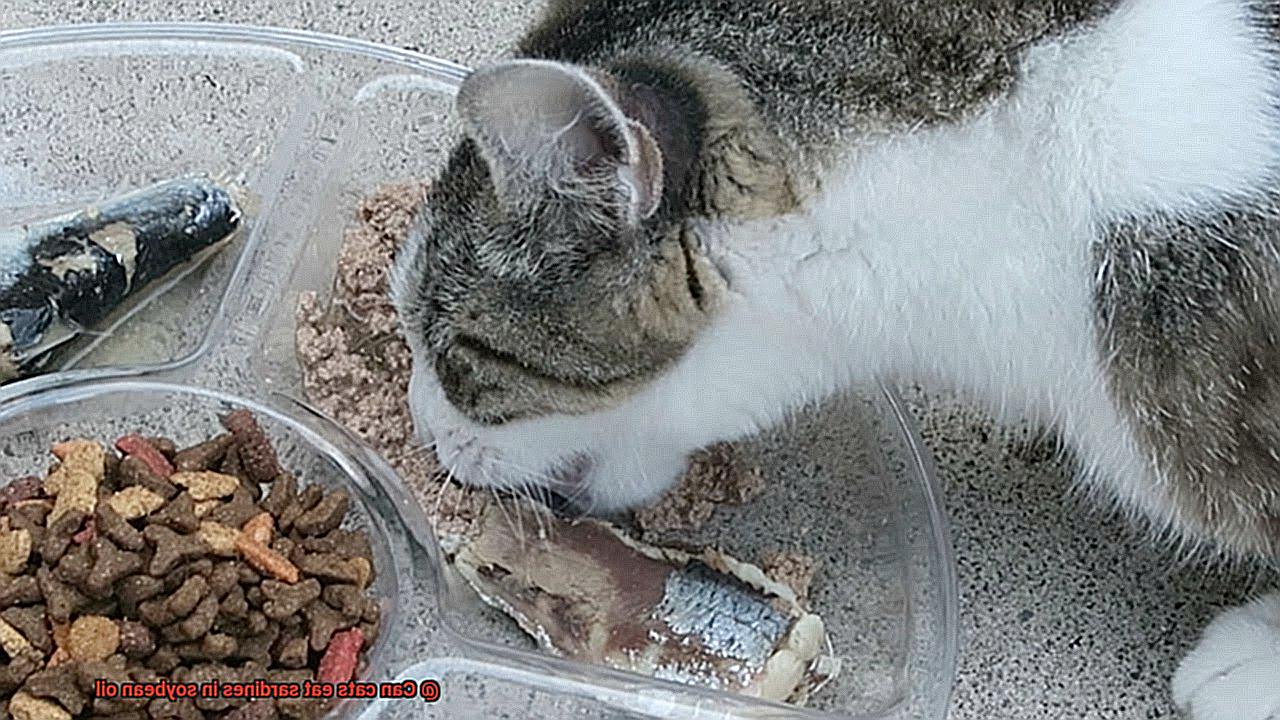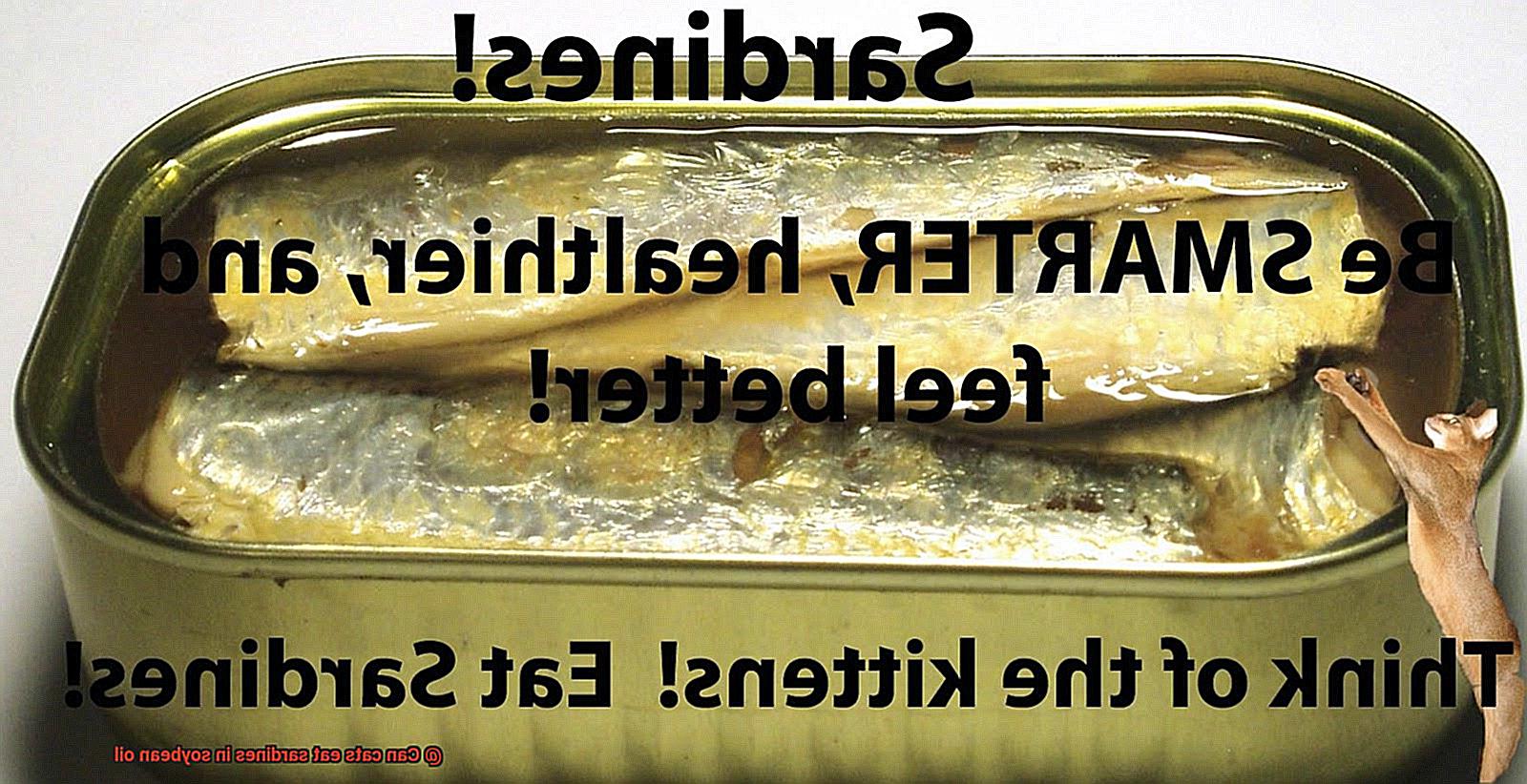As a cat owner, you know that your feline friend can be quite finicky when it comes to their food. You want to provide them with a balanced and nutritious diet that keeps them healthy and happy. However, when it comes to sardines in soybean oil, the question arises – can cats eat them?
Sardines are a human favorite for good reason. They are packed with protein and omega-3 fatty acids that offer numerous health benefits for your cat. But, the addition of soybean oil as a preservative can cause concern for some pet owners.
While sardines are an excellent source of nutrition for cats, soybean oil is not ideal. This oil contains high levels of omega-6 fatty acids that can lead to inflammation in cats and other animals. Inflammation can cause several health problems like joint pain, heart disease, and obesity.
So what’s the verdict? Can cats eat sardines in soybean oil or not? Well, it’s complicated. While canned sardines may not be the best choice for your furry friend due to the added soybean oil, there are alternatives available that offer similar benefits.
In this blog post, we’ll discuss the pros and cons of feeding your cat sardines in soybean oil and suggest alternative options that you can consider. By the end of this article, you’ll have all the information you need to make an informed decision about whether or not to include sardines in your cat’s diet.

Benefits of Sardines for Cats
And when it comes to nutrition, sardines can be a fantastic addition to your cat’s diet. These small, oily fish are packed with nutrients that can provide several benefits for your cat’s health.
One of the most significant advantages of sardines for cats is their high concentration of omega-3 fatty acids. These essential fats are crucial for maintaining healthy skin and coat, reducing inflammation, and supporting brain function. So, if you want to keep your cat’s fur shiny and their mind sharp, consider incorporating sardines into their diet.
But that’s not all. Sardines are also an excellent source of protein, vitamins B12 and D, calcium, and other essential nutrients. This means that they can support your cat’s immune system, keep their bones strong, and provide energy for their daily activities.
For cats who struggle with joint issues like arthritis, sardines may also offer relief. The anti-inflammatory properties of omega-3s can help reduce swelling and pain in joints, making it easier for your cat to move around comfortably.
There’s even more good news. Sardines are comparatively low in mercury than other types of fish. While it’s still necessary to limit the amount of fish in your cat’s diet to avoid mercury poisoning, sardines are a safer option.
To ensure your cat receives the full benefits of sardines, choose water or olive oil-packed options instead of those containing soybean oil. Soybean oil contains high levels of omega-6 fatty acids which can cause inflammation in cats if consumed in excess.
It’s also essential to keep moderation in mind when feeding sardines to your cat. While they are nutritious, overfeeding any one food can lead to nutritional imbalances.
So, if you’re looking for a healthy and tasty treat for your feline friend or want to supplement their diet with a nutritious food source, consider adding sardines. Always consult with your veterinarian before making any significant changes to your cat’s diet.
Potential Risks of Soybean Oil
While soybean oil is a common ingredient in many cat foods, it may not be the healthiest choice for your cat’s diet. In fact, there are some potential risks associated with feeding cats soybean oil that you should know about.
Firstly, soybean oil is high in omega-6 fatty acids, which can cause inflammation in the body when consumed in excess. As you may know, cats need both omega-3 and omega-6 fatty acids, but too much of either can lead to health problems. So, it’s essential to ensure that your cat’s diet has a balanced ratio of these important fatty acids.
Secondly, soybean oil may be genetically modified (GM). There is still ongoing debate about the safety of GM foods, and some experts believe that they may contribute to health issues in animals and humans. This means that it’s better to choose natural foods that don’t contain GM ingredients to avoid any potential risks.
Lastly, soybean oil may contain residual solvents from the extraction process, which could be harmful if consumed in large amounts. It’s always important to be mindful of the ingredients in your cat’s food to avoid any potential health risks.
How to Choose the Right Oil for Your Cat
Cats are not just cute and cuddly pets, but they are also obligate carnivores with specific dietary needs. As cat owners, it’s our responsibility to ensure that we meet their nutritional requirements, including the right type of oils in their diet. But with so many options available, how do you choose the right oil for your cat? Here are some ways to help you make an informed decision:
Understanding Cat’s Dietary Needs
Cats require a high amount of protein and fat in their diet and have limited ability to digest carbohydrates. It’s essential to understand their dietary needs when choosing the right oil for them.
Avoid Soybean Oil
Soybean oil may be a popular choice for humans, but it’s not a suitable option for cats. It’s high in omega-6 fatty acids, which can cause inflammation and lead to health issues such as arthritis, kidney disease, and cancer.
Opt for Omega-3-Rich Oils
Omega-3 fatty acids are essential for cats as they play a crucial role in maintaining healthy skin, coat, joints, and immune system. Look for oils that are high in omega-3 fatty acids such as fish oil or flaxseed oil.
Choose Oils Specifically Formulated for Cats
Not all oils are safe for cats, and some human-grade oils may contain ingredients that can be harmful to them. Choose oils that are specifically formulated for cats and read the label carefully before adding any new oils or supplements to their diet.
Introduce New Foods Gradually
When introducing new foods or oils to your cat’s diet, do it gradually and monitor their response for any signs of digestive issues or allergic reactions. Remember, oils should not make up a significant portion of their diet, so offer them in moderation.
Moderation is Key
But when it comes to feeding them sardines in soybean oil, remember that moderation is key.
Sardines are an excellent source of protein and omega-3 fatty acids that can benefit your cat’s health. However, too much of a good thing can be harmful, especially when it comes to soybean oil. While not toxic to cats, excessive amounts of soybean oil can cause inflammation, leading to various health issues like arthritis and heart disease. Plus, many soybean oils are genetically modified and processed with chemicals that can negatively affect your cat’s health.
To avoid these potential issues, limit the amount of sardines in soybean oil that you give to your cat. As a general rule, only give one or two small sardines per week as a treat or supplement to their regular diet. Remember, sardines should never replace a balanced and complete cat food diet.
Think of sardines in soybean oil as a delightful dessert for your cat. Just like how we shouldn’t indulge in dessert every day, our cats shouldn’t have sardines every day either. It’s okay to treat them occasionally, but moderation is key to maintain their health.
Always consult with your veterinarian before making any changes to your cat’s diet or adding supplements.
Introducing Sardines to Your Cat’s Diet
Sardines are a fantastic source of Omega-3 fatty acids, which can help maintain your cat’s skin, coat, and joints. These nutrients can also reduce inflammation and improve brain function. However, it’s crucial to choose the right type of sardines.
Many canned sardines contain soybean oil, which is not harmful but can cause inflammation if consumed in excess. This can be especially problematic for cats with inflammatory conditions like arthritis. Therefore, it’s important to feed your cat sardines in moderation.
Limit your cat’s intake to one or two small sardines per week and choose a brand that uses high-quality, sustainably sourced fish. If you do opt for canned sardines in soybean oil, drain the oil before serving them to your cat.
Alternatively, you can choose sardines packed in water or olive oil. These options are lower in omega-6 fatty acids, which means a lower risk of inflammation. Just make sure to check the ingredients list carefully and avoid any brands that contain added salt or seasonings.

Signs of an Allergic Reaction

However, it’s crucial to be aware of any potential allergic reactions they may experience from new foods.
Allergies can manifest in various ways, and some common signs of an allergic reaction in cats include vomiting, diarrhea, skin irritation, itching, and respiratory issues such as coughing, sneezing, or wheezing. If you’re considering introducing sardines in soybean oil to your cat’s diet, it’s critical to observe their reaction closely.
To avoid any adverse reactions, start by slowly introducing small quantities of sardines in soybean oil into your pet’s diet. Keep a watchful eye for any signs of an allergic response and consult with your veterinarian before making any significant changes to their diet.
Although sardines in soybean oil are generally safe for cats to eat, some cats may have an adverse reaction. Therefore, always pay close attention to your cat’s response and be on the lookout for any signs of an allergic reaction. If you notice any symptoms, stop feeding this food immediately and seek veterinary attention if necessary.
In conclusion, adding sardines in soybean oil to your cat’s diet can be a healthy and delicious treat for them. However, it’s vital always to introduce new foods slowly and monitor for any allergic reactions.
ZnmyeMrH7rE” >
Conclusion
To sum up, cats can eat sardines in soybean oil, but it’s essential to be cautious. Sardines are rich in nutrients that offer numerous health benefits for cats. However, soybean oil as a preservative can cause concern for some pet owners due to its high levels of omega-6 fatty acids.
Thankfully, there are healthy alternatives available that offer similar benefits without the risks associated with soybean oil. For instance, water or olive oil-packed sardines contain lower levels of omega-6 fatty acids and are healthier options.
It’s crucial to understand your cat’s dietary needs when introducing new foods to their diet. Choosing oils specifically formulated for cats like fish oil or flaxseed oil can provide numerous benefits while avoiding harmful ingredients like soybean oil.
Moderation is also key when feeding your cat sardines in soybean oil. Feeding them one or two small sardines per week can help maintain optimal health and wellness.
Lastly, always keep an eye out for any potential allergic reactions and consult with your veterinarian before making significant changes to your cat’s diet.







